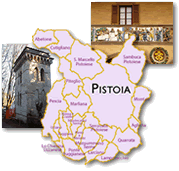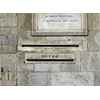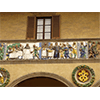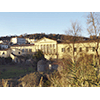Pistoia and the Pistoiese Plain

Pistoia is a city that has maintained an enviable equilibrium between recent urbanisation, consequence of a leading manufacturing and industrial activity, and its precious, carefully preserved historical centre. The heart of the city is indeed still dominated by the large factories of the communal and Renaissance age, several of which, such as the Palazzo Comunale and the Ceppo Hospital, were for centuries theatre of the scientific debates that accompanied discoveries in the medical and technological fields.
The Palazzo del Comune that looks out onto the harmonious Piazza del Duomo can be considered the cradle of Pistoiese scientific research. Since 1803, it was indeed the headquarters of the Accademia di Scienze, Lettere e Arti which for centuries was the active promoter of research and experimentation in the medical, agricultural and technological fields.

Before the French Revolution, every city, even within the same state, adopted its own units of measurement. As of 1791, a new unit of length was proposed in France, called the metre. As of the 19th century, the use of this system (the decimal metric system) progressively spread to vast areas. In this context, considerable importance is assumed by the plaques comparing the various units of measurement that were usually placed on the facades of public buildings. The portico of the Town Hall of Pistoia presents an example that compares the Florentine arm to the metre.
This building was also the headquarters of old scientific gatherings. The Main Hall hosted the meetings of the Pistoian Academy of Sciences, Letters and Arts from 1803 (year the Academy was founded) to 1811, year in which Napoleon gave the academicians the premises of the suppressed convent of Santa Maria del Carmine of Pistoia. The Academy was born with the name of Academy of Various Literatures, by initiative of several teachers of the Fonteguerri College and eminent personalities of the city. The members promoted literary, historical, philosophical, social and scientific studies with a preference, in the early years, for the physical and mathematical sciences. Later, under the influence of the studies of economy promoted by the Accademia dei Georgofili, problems tied to economy and agriculture were also discussed. In 1813, four classes were formed: Moral Sciences, Mathematical and Physical Sciences, Economic Sciences, Literature and Fine Arts. It was closed from 1831 to 1838 as a preventive measure against the political disorders tied to the Risorgimento climate. At its reopening, it participated with numerous delegations in the Congresses of Italian Scientists, and organised artistic, industrial and agricultural exhibitions for the Pistoian territory. In 1891, it ceased all activity.
In 1821, in the ambit of the Pistoian Academy, the "Società dei Parentali ai grandi italiani" [Parentalia Society to Great Italians] was born, the first in Italy, which ideally evoked the ancient Parentalia celebrated by the Romans. The Pistoian celebrations, held at the expense of the Society, were hosted in the classrooms of Forteguerri College or in the main salon of Town Hall. Among the various figures commemorated, we must also indicate men of science like Galileo Galilei and Filippo Pacini. The Society ceased activity as of 1857, but the celebrations continued until 1885 with the sole support of the Pistoian Academy of Sciences, Letters and Arts.
(Graziano Magrini)
A short distance ahead, taking Via Filippo Pacini, we arrive at the city’s other famous architectural emergence: the Spedale del Ceppo. The Brunelleschian facade conceals a hospital institution which from the 17th century was one of the most celebrated schools of surgery in Tuscany, whose memory today survives in the very interesting Museum of Surgical Instruments.

Founded in 1277, the Hospital of the Infirm, known as Santa Maria del Ceppo, is one of the very oldest hospitals in Tuscany. Its name comes from an ancient tradition that recalls a "ceppo", or stump, from a chestnut tree used to collect the first contributions for building the hospital. In the following years the hospital grew rapidly thanks to numerous donations. During the Middle Ages, like other similar institutions, it was dedicated to providing relief for the poor and the ill, especially during the recurrent famines and epidemics. Near the end of the 15th century the hospital was the object of strongly conflicting interests among the city’s factions, to the point that, in 1502, it was put under the jurisdiction of the Florentine Hospital of Santa Maria Nuova.
In the early years of the 16th century the loggia was built, recalling the one designed by Brunelleschi for the Hospital "degli Innocenti". On the facade, above the loggia, the splendid glazed terracotta frieze was accomplished between 1526 and 1528. It is the work of Giovanni della Robbia and Santi Buglioni except for one panel ("Give drink to the thirsty") by the Pistoia artist Filippo di Lorenzo de' Paladini. The seven great panels of which the frieze is composed represent the Works of Charity, in alternation with the Cardinal and Theological Virtues.
The panel illustrating doctors examining patients is highly effective, as regards iconography pertaining to medicine. Against a white background evocative of the hospital environment, a physician is feeling the pulse of a sick old man, his face contorted in suffering, while an elderly personage, perhaps a servant, holds an ampule. Behind them, the pupils are waiting for the doctor to pronounce his diagnosis. At the centre of the scene appears Leonardo Buonafede, director of the Ceppo, shown listening to a doctor. The scene continues with two assistants who are helping a surgeon treat a young patient’s head wound.
In 1778 the Ceppo Hospital won back its former independence from Florence and, a few years later, Grand Duke Peter Leopold of Lorraine merged it with the San Gregorio, an ancient hospice in Pistoia that took in abandoned children, thus decreeing the birth certificate of the Associated Hospitals.
The hospital had a School of Medicine and Surgery, perhaps founded in the 1780s, although it is probable that lessons in medicine were taught here already in the previous century. In 1784 the Grand Duke approved its regulations, instituting five chairs (Practical Medicine, Institutions of Surgery, Anatomy, Practical Cases, Operations and Obstetrics) with the necessary provision of instruments. Upon completing the courses, the students had to go to Florence to take the final exam. The school trained valid physicians, among them the anatomist Filippo Pacini, until in 1839, with the reform of the system of higher studies, its closure was decreed due to the low number of students. Testimony to the school remains in the collection of antique surgical instruments kept in a special museum.
The Museum of Surgical Instruments, set up in an ancient room in the hospital, contains urological, obstetrical and orthopedic-traumatological instruments dating mainly from the 18th through the early 19th century. The instruments are of Pistoian, national (Bologna) and international (England and France) make. The Museum also contains a collection of medical texts. In the garden of the Hospital stands the restored anatomical amphitheatre dating from the 17th century.
Lastly, the pharmaceutical laboratory contains various items dating from the 18th to the 20th century: benches for the preparation of Galenic products, pharmaceutical glassware, a collection of vases and cabinets for the conservation of medicinal herbs. In the near future the Pisa ASL 3 Historical Museum, now being set up, will include the collections of the Museum of Surgical Instruments.
(Graziano Magrini)
The immediate outskirts of the city conceals villas and parks of unexpected elegance. Such is the case of Villa Puccini on Via Dalmazia, with its immense park created by Niccolò Puccini between 1820 and 1840, which is populated with monuments and pavilions dedicated to great men of science.

Known with the name of "villone", the villa was built for Tommaso Puccini in the first half of the 18th century with the earnings from his profession as physician, and was modified in the course of time until it assumed its present neoclassical look.
In the 19th century, Niccolò Puccini, a promoter of the Parentalia Society to Great Italians, placed at the disposal of Filippo Pacini a microscope that the Pistoian scientist used in the villa to conduct his first anatomical and histological studies.
The spacious garden, realised between 1821 and 1844 by order of Niccolò Puccini, was furnished with various buildings, several of which were dedicated to science: a Pantheon to illustrious men, a Temple of Pythagoras, a monument to science, one to industry, a hemicycle dedicated to Galileo Galilei and a column surmounted by a statue of Carl Linnaeus, to whose memory the park was dedicated. The disposition of the hydraulic structure of the two lakes and of the brooks was entrusted to Pistoian architect Giovanni Gambini who, in that period, was also working on Villa Celle.
Emanuele Repetti defined the garden as a place «enchanted that would be difficult to describe as it deserves». Today, it no longer presents its original aspect, and several of its monuments have disappeared. Substantially unchanged, however, is the Gothic Castle (or Fortress), one of the monumental buildings that enriched the garden and that in 1836 became the habitual residence of Niccolò Puccini. Precise nineteenth-century descriptions, drafted on the occasion of the sale by auction of the property, testify that the middle tower had a lighting conductor on top of the roof, and curious contraptions which, according to a widespread anecdote, permitted Niccolò Puccini not to abandon his bedroom to receive guests: «the inner wall of this bedroom houses various brass handles that, by means of a proper mechanism, serve to open and close the window, open and close the entry gate and other uses, today out of order».
The property was divided first due to the construction of the road for Porretta, the new Via Leopolda (1847), and then by the construction of the Porrettana Railway (1864). The area that embraces the Fortress, the Gothic temple, the pantheon and several monuments, including the one to Galileo, were purchased in 1867 by Florentine attorney Oreste Ciampi. The remaining part of the complex is today a public park.
(Graziano Magrini)
Backtracking and taking Via del Villone, then Via Bartolomeo Sestini and Via Montalese, we instead discover the baroque Villa Celle with a winding service road that was probably built by Leonardo Ximenes.
Villa Celle began to take on its present appearance as of the second half of the 17th century, when the Fabroni family began to modernise it. Cardinal Carlo Agostino Fabroni, in particular, organised the orchard plantations, the farms, and reordered the waterworks, building pools, nymphaeums and fountains. The facade is characterised by its large Baroque pediment and clock, which recalls the analogous solution of the Villa di Bellavista. In the second half of the 18th century, work began on the villa’s new service road, which tradition claims was done on a project by Leonardo Ximenes. The gardens and woods were laid out on typically Baroque geometric schemes. A "Chinese" aviary of brick and iron was built in 1812. Between 1841 and 1842, a rectangular waterbody was excavated on the northern edge of the woods to produce the ice for the icehouse, which was formed by a well having the shape of a truncated cone, made of dry-walled stone blocks, and equipped with a drainage canal and a catch basin for the infiltration waters. The icehouse water was also utilised in the dairy, a small building that recalls the icehouses of the Pistoian mountain.
The transformation into a romantic park was carried out in the mid 19th century under the direction of Pistoian architect Giovanni Gambini. The little "Chinese" lake with natural forms was inaugurated in 1845. Its little island resting on grottoes had a berth for small boats and a little neoclassical temple. A small bridge that passed over a rocky ravine with a waterfall led to the lake. The year 1848 marked the onset of work on an amphitheatre with natural forms, crowned by the neo-gothic "Temple of the Fountain-head" (today the "Tea House"). The results that Gambini achieved were so remarkable that Niccolò Puccini summoned him for the lake of his own villa at Scornio.
In the late 19th century, the lemon-house was renovated to its present form, and the Michelucci Foundry was commissioned with manufacturing the gates for the villa and farm. During World War II, the villa was occupied by a German military command post and transformed into a hospital, while a bunker was excavated in the park. In 1969, the Celle property was purchased by entrepreneur Giuliano Gori who collected contemporary art, and here formed the first collection of environmental art.
(Graziano Magrini)
****************************
Texts by Elena Fani
English translation by Victor Beard
Last update 17/ott/2008



 = libraries and archives
= libraries and archives  = scientific research centers
= scientific research centers  = memorial places of scientists
= memorial places of scientists = public health places
= public health places = places of science and worship
= places of science and worship = places of technology
= places of technology  = museums and collections
= museums and collections  = villas and gardens of science
= villas and gardens of science

